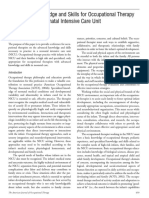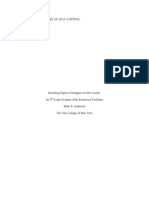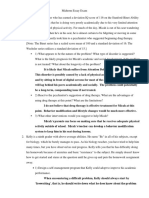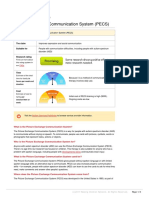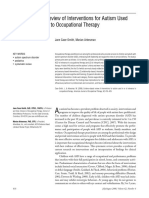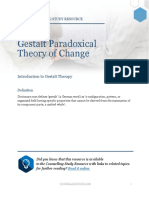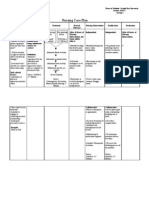OT and Eating Dysfunction
OT and Eating Dysfunction
Uploaded by
MCris EsSemCopyright:
Available Formats
OT and Eating Dysfunction
OT and Eating Dysfunction
Uploaded by
MCris EsSemOriginal Description:
Original Title
Copyright
Available Formats
Share this document
Did you find this document useful?
Is this content inappropriate?
Copyright:
Available Formats
OT and Eating Dysfunction
OT and Eating Dysfunction
Uploaded by
MCris EsSemCopyright:
Available Formats
Occupational Therapy and
Eating Dysfunction
(position Paper)
T
he American Occupational Therapy Association • Initiating treatment to normalize impairments
(AOTA) asserts that occupational therapy is an in oral facial sensitivity.
essential service for the comprehensive man- • Inhibiting abnormal oral-motor and/or pos-
agement of eating dysfunction. Eating is a significant tural reflexes and facilitating age-appropriate
performance area of daily liVing skills throughout a responses to promote function.
person's life. The Uniform Terminology System for • Introducing compensatory techniques to mini-
Reporting Occupational Therapy Services refers to mize the effects of Visual-perceptual problems
eating/feeding as "the skill and performance of se- that affect eating performance.
quentially feeding oneself, including sucking, chew· • Using developmentally appropriate activities to
ing, swallowing, and the manipulation of appropriate facilitate the dynamic and static postural con-
utensils" (AOTA, 1986, p. VIII.13). Many problem trol necessary for eating.
areas within the person's environment affect the eat- • Addressing functional activities to increase
ing/feeding process, including deficits caused by range of motion, coordination, strength, and
sensorimotor, perceptual, neurological, cognitive, or prehension necessary for self-feeding.
psychosocial factors. Feeding is the process of getting • Addressing cognitive issues to ensure that safe
food to the mouth, while eating is the process of eating practices are followed.
moving food from the mouth to the stomach. Al- • Encouraging socially appropriate eating behav-
though occupational therapy has a critical role in the iors and activities.
treatment of psychosocial eating disorders and related • Using specialized seating and orthoses to
behavior problems, that role will not be addressed in achieve appropriate positioning, prOViding
this paper. functional equipment or utensils to assist with
The ability to feed oneself independently in self-feeding, and devising adaptations for pa-
order to meet nutritional needs is assessed and tients dependent on life-support systems or en-
treated by the occupational therapist. Aspects of the vironmental controls.
physical and social environment that affect feeding
performance are addressed. Reinstitution of oral Occupational therapy is a qualified and valued
feeding in persons nourished by prolonged nonoral service in the management of eating dysfunction.
methods (e.g., central venous nutrition, nasogastric Through collaboration with other professionals, occu-
feeding, gastrostomy) is facilitated. Occupational pational therapists promote maximal independence
therapists differentiate eating difficulties intrinsic to in all components of eating.
the patient, such as dysphagia, from those that involve
the caregiver's knowledge and skill.
Reference
Eating functions are complex and require com-
prehensive assessment and treatment. Advanced edu- American Occupational Therapy Association. (1986).
cation and clinical practice are essential prerequisites Uniform terminology system for reporting occupational
for using specialized evaluations such as videofluo- therapy services. In Reference manual of the offiCial docu-
roscopy and techniques such as complex oral motor ments afThe American Occupational Therapy Association,
facilitation. Occupational therapy assessment and Inc. (pp. VIII.12-VIII.18). Rockville, MD: Author.
treatment focuses on the following areas:
Prepared by members of the Commission on Practice with contri-
• Treating impairments of tone, strength, coordi- butions from Annette van Boldrick, OTR, Marcia S. Cox, OTR/L, Mar-
nation, and movement patterns of the muscles ilyn Dennis Daniel, MPA, OTR, Mary Godfrey, oTR,janis Hunter, OTR,
Christy L. A. Nelson, MS, OTR, Lillian Hoyle Parent, MA, OTR, FAOTA,
of the face, lips, jaw, tongue, and pharynx to Margaret Phillips, MS, OTR, Dianna Puccetti, OTR, and Laura
attain the oral-motor control necessary to ma- Schllller, OTR, for the Commission on Practice (L. Randy Strickland,
EdD, OTR, FAOTA, Chair)
nipulate and swallow various textured foods
Approved by the Representative Assembly April 1989
and liquids.
The Americanjournal of Occupational Therapy 805
Downloaded From: http://ajot.aota.org/ on 02/14/2018 Terms of Use: http://AOTA.org/terms
You might also like
- Interest Checklist UK (Adapted)Document11 pagesInterest Checklist UK (Adapted)Fiona 'Hope' Rae100% (1)
- Grant Proposal PromptDocument17 pagesGrant Proposal Promptapi-320564931No ratings yet
- Vergara, J. - T.O. in The Neonatal Intensive Care UnitDocument11 pagesVergara, J. - T.O. in The Neonatal Intensive Care UnitFedora Margarita Santander CeronNo ratings yet
- Opening A Private Practice in Occupational Therapy: Earn .1 Aota CeuDocument9 pagesOpening A Private Practice in Occupational Therapy: Earn .1 Aota CeuRey John Monje100% (1)
- AOTA Evidence-Based Practice Project CAP Worksheet Evidence Exchange Last Updated: 8/25/2016Document7 pagesAOTA Evidence-Based Practice Project CAP Worksheet Evidence Exchange Last Updated: 8/25/2016Marina ENo ratings yet
- OT Practice June 4 IssueDocument27 pagesOT Practice June 4 IssueThe American Occupational Therapy AssociationNo ratings yet
- Psychology Notes IntelligenceDocument7 pagesPsychology Notes IntelligenceShivaprasad HalemaniNo ratings yet
- Self Control ResearchDocument44 pagesSelf Control ResearchMark R Anderson80% (5)
- Task 3: Graphic Organizers (20%) Article 1: Causes of Child AbuseDocument2 pagesTask 3: Graphic Organizers (20%) Article 1: Causes of Child AbuseShiao Mei YeongNo ratings yet
- Q & A Human BehaviorDocument189 pagesQ & A Human BehaviorAngel King Relatives100% (1)
- Midtermessayexam 2Document2 pagesMidtermessayexam 2api-363654403No ratings yet
- Walter Kaufmann Ac 2012 SymposiumDocument41 pagesWalter Kaufmann Ac 2012 SymposiumErwin SyahNo ratings yet
- Picture Exchange Communication System (PECS)Document3 pagesPicture Exchange Communication System (PECS)Fathur RNo ratings yet
- 2 Sensory Processing Measure - Preschool (SPM-P) - Pearson AssessmentDocument1 page2 Sensory Processing Measure - Preschool (SPM-P) - Pearson AssessmentVINEET GAIROLANo ratings yet
- Cerebral Palsy SlidesDocument22 pagesCerebral Palsy Slidesapi-301967651No ratings yet
- OT in Pediatrics Quick Reference GuideDocument2 pagesOT in Pediatrics Quick Reference GuideMaya JohnsonNo ratings yet
- SP2 School Full Assessment and Planning ReportDocument8 pagesSP2 School Full Assessment and Planning Reportkishan310No ratings yet
- WeeFIM Clinical ReviewDocument10 pagesWeeFIM Clinical Reviewsss_sarzzzNo ratings yet
- The Performance Quality Rating Scale (PQRS) : Reliability, Convergent Validity, and Internal Responsiveness For Two Scoring SystemsDocument8 pagesThe Performance Quality Rating Scale (PQRS) : Reliability, Convergent Validity, and Internal Responsiveness For Two Scoring SystemsCarol AlvaradoNo ratings yet
- Marcus Evaluation - StruthersDocument8 pagesMarcus Evaluation - Struthersapi-355500890100% (1)
- Evaluation of Feeding, Eating, and Swallowing For Children With Cerebral PalsyDocument9 pagesEvaluation of Feeding, Eating, and Swallowing For Children With Cerebral Palsyanner.socialsNo ratings yet
- OT TerminologyDocument57 pagesOT Terminologynacole78No ratings yet
- Ot 103-Finals NotesDocument22 pagesOt 103-Finals Notessanchez.clarisse080603No ratings yet
- OT Practice August 6 IssueDocument19 pagesOT Practice August 6 IssueThe American Occupational Therapy AssociationNo ratings yet
- Occupational Therapy Survival GuideDocument12 pagesOccupational Therapy Survival Guideapi-256686248No ratings yet
- Case Study For BipolarDocument7 pagesCase Study For Bipolarapi-285705203No ratings yet
- Forensic Psychiatry and Occupational TherapyDocument3 pagesForensic Psychiatry and Occupational TherapyVuyokazi Nosipho MajolaNo ratings yet
- Wee FimDocument9 pagesWee FimdeffyNo ratings yet
- The Effect of Co-Op Approach in Improving Visual Motor Integration Skills in Children With Learning DisabilityDocument7 pagesThe Effect of Co-Op Approach in Improving Visual Motor Integration Skills in Children With Learning DisabilityIJAR JOURNALNo ratings yet
- Occupational Therapists Prefer Combining PDFDocument12 pagesOccupational Therapists Prefer Combining PDFSuperfixenNo ratings yet
- Model of Human Occupation (MOHO)Document6 pagesModel of Human Occupation (MOHO)Rebecca MarquesNo ratings yet
- Aquatic Therapy For Occupational Therapy Education and PracticeDocument123 pagesAquatic Therapy For Occupational Therapy Education and PracticeAURORA BADIALINo ratings yet
- Feeding Therapy in A ChildDocument11 pagesFeeding Therapy in A ChildCarolina Lissette Poblete BeltránNo ratings yet
- Movement Difficulties in Developmental Disorders: Practical Guidelines for Assessment and ManagementFrom EverandMovement Difficulties in Developmental Disorders: Practical Guidelines for Assessment and ManagementNo ratings yet
- 2001 Candidate Handbook: National Board For Certification in Occupational Therapy, Inc. (Nbcot)Document54 pages2001 Candidate Handbook: National Board For Certification in Occupational Therapy, Inc. (Nbcot)engshi18No ratings yet
- 4th Sem 651 Occupational ProfileDocument19 pages4th Sem 651 Occupational Profileapi-291545292100% (1)
- Play AND Autism: Marisa Lobo Biddappa M.A. M.PhilDocument46 pagesPlay AND Autism: Marisa Lobo Biddappa M.A. M.Philtamara badrovNo ratings yet
- Neuropsychological Outcome of Cognitive Training in Mild To Moderate Dementia A Randomized Controlled TrialDocument20 pagesNeuropsychological Outcome of Cognitive Training in Mild To Moderate Dementia A Randomized Controlled TrialNeuropsi SigloXXINo ratings yet
- Effectiveness of Paediatric Occupational Therapy For Chidren With Disabilities A Systematic ReviewDocument16 pagesEffectiveness of Paediatric Occupational Therapy For Chidren With Disabilities A Systematic ReviewCynthia RodriguesNo ratings yet
- OT Profile As A GuideDocument8 pagesOT Profile As A GuideClara WangNo ratings yet
- HemiplegiaDocument5 pagesHemiplegiaRyan TOgzNo ratings yet
- Ota Group ProtocolDocument26 pagesOta Group Protocolapi-318685839No ratings yet
- MOHO Intervention Implementation - GUADALQUIVERDocument3 pagesMOHO Intervention Implementation - GUADALQUIVERKoyceNo ratings yet
- Developmental ForDocument16 pagesDevelopmental ForAarthi ArumugamNo ratings yet
- Short Course 360 Wcpa Aota 2018Document46 pagesShort Course 360 Wcpa Aota 2018api-405162391100% (1)
- Topss Poster PDFDocument1 pageTopss Poster PDFUNNo ratings yet
- Case Study Paper FinalDocument19 pagesCase Study Paper Finalapi-240832658100% (1)
- Feeding InterventionsDocument8 pagesFeeding Interventionsapi-234536968No ratings yet
- Evidence Based Review of Interventions For Autism Used in or of Relevance To Occupational TherapyDocument14 pagesEvidence Based Review of Interventions For Autism Used in or of Relevance To Occupational Therapyapi-308033434No ratings yet
- Pediatric OSCE Documentation PDFDocument9 pagesPediatric OSCE Documentation PDFSarah LaytonNo ratings yet
- Occupational Therapy As A Major Activity of Human Being: by Rafia KhalidDocument20 pagesOccupational Therapy As A Major Activity of Human Being: by Rafia Khalidnomi9818No ratings yet
- PediOT Intake FormDocument4 pagesPediOT Intake Formmuffy lucasNo ratings yet
- Occupational Therapy Evaluations in ChildrenDocument87 pagesOccupational Therapy Evaluations in ChildrenScribdTranslationsNo ratings yet
- Occupational Therapy (2014)Document4 pagesOccupational Therapy (2014)Ali GhahremanNo ratings yet
- Adl & Iadl PresentationDocument52 pagesAdl & Iadl PresentationHemanth S100% (2)
- Intact and Impaired Memory Functions in AutismDocument21 pagesIntact and Impaired Memory Functions in Autismdruga godinaNo ratings yet
- OT Progress Report RandallDocument4 pagesOT Progress Report Randallrhyan.landicho1998No ratings yet
- Visual Motor Skills: Visual Perception Visual ProcessingDocument3 pagesVisual Motor Skills: Visual Perception Visual ProcessingSaif Ullah KhalidNo ratings yet
- Occupational Therapy and Mental Health 1Document18 pagesOccupational Therapy and Mental Health 1Roman -No ratings yet
- Source-Oriented (SO) Charting Is ADocument3 pagesSource-Oriented (SO) Charting Is AEnrico Charles Manzano100% (1)
- Medication Support For DIR Programs October 28 2011 Tel AvivDocument127 pagesMedication Support For DIR Programs October 28 2011 Tel AvivcirclestretchNo ratings yet
- ADHD Home ProgramDocument5 pagesADHD Home ProgramdahocctherapyNo ratings yet
- Using Sensory Integration andDocument9 pagesUsing Sensory Integration andVero MoldovanNo ratings yet
- Soap 11Document4 pagesSoap 11api-436429414No ratings yet
- Sensory Processing Pre Referral Advice Oct18Document43 pagesSensory Processing Pre Referral Advice Oct18Raka Rida100% (2)
- Presented By: Ashlee Barbeau Student Occupational Therapist, Queen's UniversityDocument22 pagesPresented By: Ashlee Barbeau Student Occupational Therapist, Queen's UniversityDanielle Stella N'LucaNo ratings yet
- Makingan Autism Spectrum Disorder DiagnosisDocument36 pagesMakingan Autism Spectrum Disorder DiagnosisGeruza OliveiraNo ratings yet
- Knox Prescool PlayDocument7 pagesKnox Prescool Playkonna4539No ratings yet
- Gestalt Paradoxical Theory of Change: Counselling Study ResourceDocument6 pagesGestalt Paradoxical Theory of Change: Counselling Study ResourceMich Ram100% (1)
- File PDFDocument104 pagesFile PDFLaili ZikriyaNo ratings yet
- WorkaholicDocument3 pagesWorkaholicIgnatius TisiNo ratings yet
- ignou Guru: AssignmentDocument13 pagesignou Guru: AssignmentAshwini Tyagi100% (1)
- NCP - Risk For InjuryDocument2 pagesNCP - Risk For InjuryIngrid Sasha Fong75% (12)
- Selective MutismDocument2 pagesSelective MutismTee Kok KeongNo ratings yet
- UTS TP2 1flowchartDocument1 pageUTS TP2 1flowchartAngela NacpilNo ratings yet
- ASD AdultDocument3 pagesASD AdultJ. M. Solis100% (1)
- Position Paper in BullyingDocument2 pagesPosition Paper in BullyingJem Caralipio67% (9)
- Drama Therapy and MetaphorsDocument12 pagesDrama Therapy and MetaphorsAnshuma Kshetrapal100% (3)
- Mentalization-Based Treatment For Pathological Narcissism Robert P. Drozek All Chapter Instant DownloadDocument24 pagesMentalization-Based Treatment For Pathological Narcissism Robert P. Drozek All Chapter Instant DownloadavevorzorenNo ratings yet
- Psychological Domain - Nursing Care PlanDocument1 pagePsychological Domain - Nursing Care PlanPussykate DollNo ratings yet
- Altered Sensory and Disturbed Thought ProcessDocument4 pagesAltered Sensory and Disturbed Thought ProcessRosecinie Torrente100% (2)
- NCP PsychDocument2 pagesNCP PsychJray Inocencio50% (4)
- Daftar PustakaDocument18 pagesDaftar PustakaZurezki Yuana YafieNo ratings yet
- Teen Drug Abuse EssayDocument4 pagesTeen Drug Abuse Essayapi-280938960No ratings yet
- IHBAS ProspectusDocument31 pagesIHBAS Prospectusshahmed999No ratings yet
- Durbin, Tribute To Viktor Frankl, 2005Document73 pagesDurbin, Tribute To Viktor Frankl, 2005DrBertram ForerNo ratings yet
- Wrinkled Heart Lesson PlanDocument2 pagesWrinkled Heart Lesson Planapi-265041352No ratings yet
- Subject Psychology: Paper No.9: Positive Psychology Module No.21: Goal-SettingDocument14 pagesSubject Psychology: Paper No.9: Positive Psychology Module No.21: Goal-SettingHappyMinds7No ratings yet
- Posttraumatic Stress DisorderDocument1 pagePosttraumatic Stress DisorderStephanie R. S. HsuNo ratings yet
- Purposes of Clinical Assessment InterviewDocument2 pagesPurposes of Clinical Assessment InterviewRachelle SalcedoNo ratings yet


